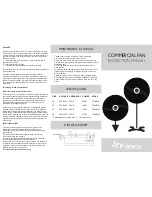
Manufacturer of Quality Air Conditioning and Heating Products • www.islandaire.com • sales@islandaire.com • (800)-886-2759
39
Remote Thermostats
Remote Thermostat
Control
The PTAC unit can be controlled by any remote elec-
tronic thermostat that can interface with RCBWYG ter-
minals. A wiring harness is provided with conductors for
all applications (Heat Cool, Heat Pump, Multispeed Fan,
etc.). See details on the next page. The Control Selection
jumper must be in T’STAT position. During a call, the
remote thermostat will pass R back to the controller on
a respective terminal. The push buttons on the touchpad
become inactive in the remote thermostat mode.
Note: In terms of outputs, there are two types of thermo-
stats: Relay Contacts and Solid State.
Manufacturers of solid state output thermostats include
loading resistors in their installation kits. These 560
Ohm, 3W resistors are designed to load thermostat solid
state outputs in order for the output voltage to be either
0 or 24 Vac (i.e., no floating voltage). These resistors are
connected from W, Y, G to common (C), respectively.
You can wire any type of 24 Vac thermostat straight into
the Remote Thermostat Interface on the PTAC control
board (see page 40).
Wireless Wall
Thermostat
Wireless wall thermostats are designed to provide precise
temperature control without the installation labor and
expense of wiring.
• Powered by AA batteries
• Mounts in any suitable location that will provide
an accurate room temperature reading.
• Large LCD display provides the user with current
room temperature, set point temperature, time,
program interval, and other system status informa-
tion.
REmOTE CONTROL NODE
Used with a wireless wall thermostat, the RCN commu-
nicates with the thermostat using unlicensed 900 MHz,
radio frequency energy.
Energy Saving Options
Automatic Change-Over Remote Mounted Thermostats
can be obtained to switch from heating to cooling and
from cooling to heating automatically. With automatic
change over, the operation of the heating cycle or the
cooling cycle is determined by the temperature require-
ment of the space.
Most thermostats with this feature are set to change
over when the room temperature varies 3-½ °F from
the set-point. The unit is placed in cooling mode when
the set-point is over 3-½ °F; 3-½ °F under the set point
places the unit in the heating mode. This 3-½ °F varia-
tion is usually adjustable from a ½ °F dead band to a 5 °F
dead band. Each cycle is run until the set point tempera-
ture is reached, then that cycle is de-energized. On some
thermostats, the automatic change over function can be
overridden manually by moving the thermostat selector
switch to “heat” or to “cool.”
Fan operation with an automatic change over thermostat
is controlled by the fan selector switch. When placed in
the “fan” mode, the fan runs continuously. When placed
in the “auto” mode, the fan will only energize when the
thermostat calls for heating or cooling.
















































